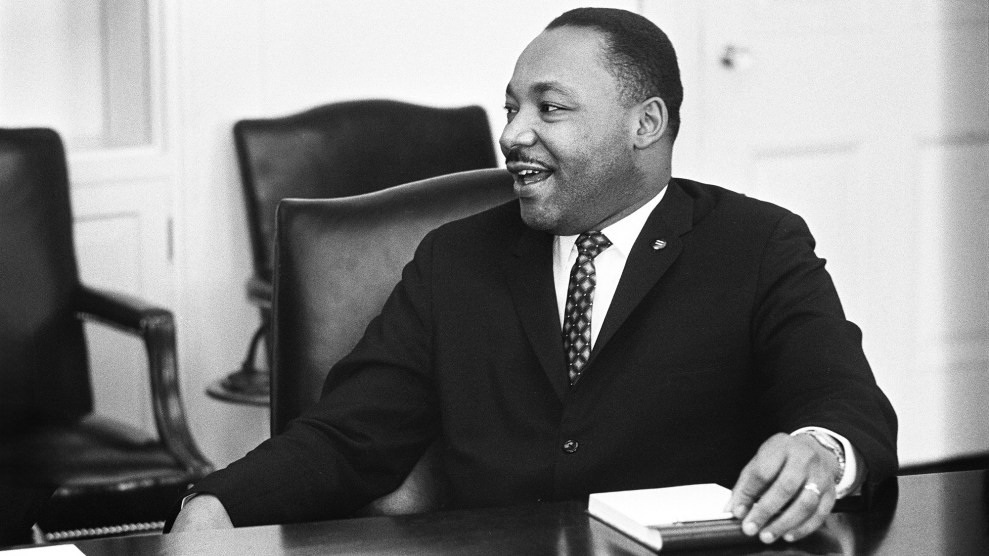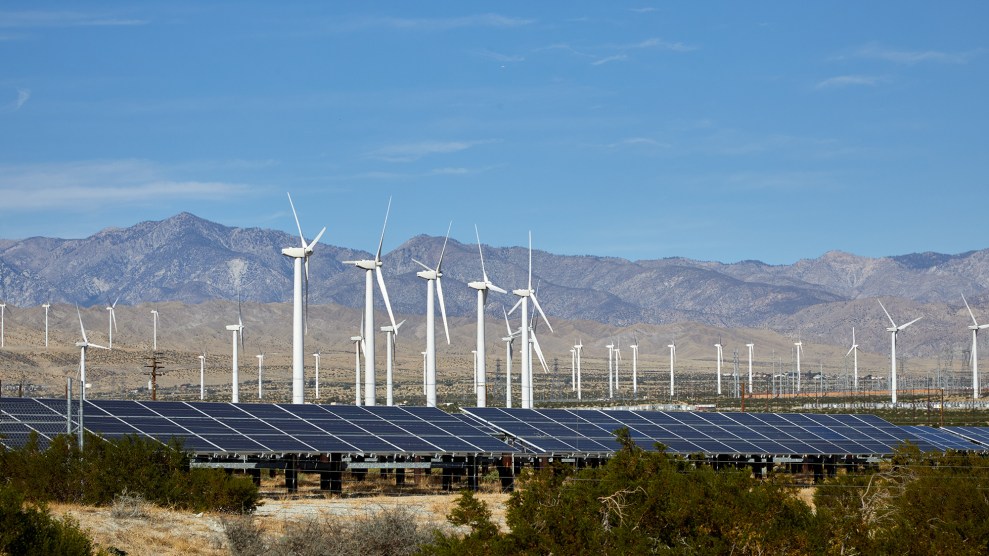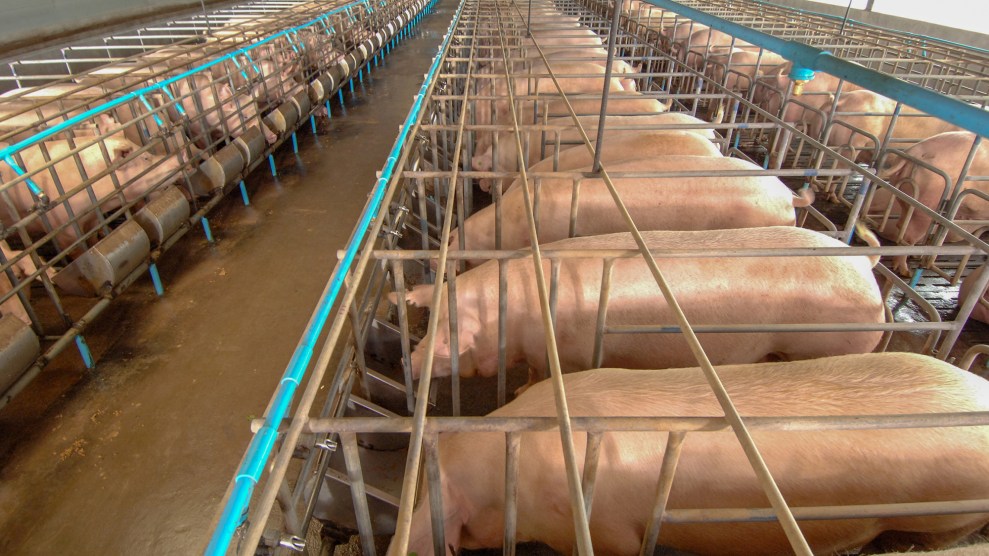
Sows in a breeding facility.Chayakorn Lotongkum/Getty Images
This story was originally published by Canada’s National Observer and is reproduced here as part of the Climate Desk collaboration.
Amy Soranno could have said she was sorry. She knew that was her last, best shot at avoiding prison for her role in organizing the occupation of the Excelsior hog farm near Abbotsford, British Columbia, on the morning of April 28, 2019.
But at her sentencing hearing at the end of this summer, Soranno doubled down. In the closing statement she delivered in a BC courtroom, she made it clear she’d do it all again if it would help save pigs from their suffering. As she spoke, the judge was mulling whether or not to send her to jail. Soranno’s closing statement was the last thing he heard before her sentencing on October 12.
There was no doubt about the extent of Soranno’s involvement in the hog farm occupation. On that day three years ago, she and more than 50 fellow activists stormed the breeding room with iPhones in hand, then broadcast their sit-in over Instagram Live for the next seven hours. It was the first time anyone had done this kind of thing in Canada. It wouldn’t be the last.
The sit-in was a response to gruesome video footage allegedly taken by cameras hidden at Excelsior and released a few days earlier by People for the Ethical Treatment of Animals (PETA). That footage showed mother pigs languishing in gestation crates next to dead and dying piglets, as well as older pigs with hernias, tumors, and various lacerations. It also captured workers electric-prodding other pigs in the face and casually castrating piglets without anesthetic. In one scene, a dead pig is being eaten by its fellows.
The scenes Soranno and her fellow activists captured later were less gruesome. There were no deformed pigs, no workers inflicting any pain or suffering. Still, the sight of hundreds of sows confined to filthy gestation crates—metal cages too small for them to turn or scratch themselves—made for grim viewing.
“Our goal was to get mass media attention, not only on Excelsior, but the fact that this farm is representative of the entire industry,” Soranno told me shortly before her sentencing hearing. PETA’s footage hadn’t been enough, she explained. There was no way to prove it came from Excelsior, for one thing. For another, it was illegally obtained and so would not be admissible in court. “But if you go in first-hand and you’re livestreaming,” Soranno said, “it’s really indisputable.”
Unfortunately for Soranno, the gestation crates she and her fellow activists witnessed are perfectly legal. Like battery cages for hens and feedlots for cattle, holding sows in body-sized cages for months at a time is standard practice at most of Canada’s 3,000 pig-breeding facilities.
This meant Excelsior wasn’t breaking any laws. But by storming the hog farm to protest, Soranno was. This past July, she and one other activist were convicted of breaking and entering and mischief—another Canadian first for an animal rights activist.
“It’s disgusting that our government’s response to this systemic abuse and the footage that keeps surfacing is…to criminalize those who expose that,” Soranno told me. But civil disobedience often involves breaking laws one agrees with (like those protecting private property) to shine a light on laws one considers unjust—or in the case of farm animal welfare, laws that don’t exist. Wasn’t she being dishonest, pleading not guilty to a crime she’d filmed herself committing?
Soranno acknowledges her plea was more of a political strategy than a legal one. Forcing the case to trial wasn’t about Excelsior or even pigs, she added. It was meant to take aim at a factory farm system that slaughters more than 825 million animals each year in this country. The goal wasn’t to get acquitted, she said. “It’s how can we make this a political show trial? And if we pled guilty, we wouldn’t have achieved that goal.”
Still, she doesn’t want to go to jail. Expressing contrition was her last chance to prevent that from happening. Yet during her closing statement, Soranno made clear the only thing she felt bad for was failing to save Excelsior’s pigs: “While I may not be able to apologize for my actions, I would like to apologize to the animals.”
The judge cut her off a few moments later and refused to let her finish. That’s how the day ended. He would later find her guilty, with the sentence to be determined at a later date.
It’s not always the activists who wind up on trial. Over the past 10 years, a wave of activist-driven factory farm exposés have repeatedly forced the industry to defend itself both in and out of court. The earliest exposés were legal acts of subterfuge: Activists took jobs on farms in order to become whistleblowers. Those investigations spurred a handful of genuine reforms, including a self-imposed ban on veal crates by meat producers. But frustration at the glacial pace of change caused some activists to escalate their tactics; the occupation of Excelsior marked a new and more aggressive phase of activism that has spread across the country. The question is, has it backfired?
Camille Labchuk, now the executive director of the animal law group Animal Justice, was at the forefront of that first wave. In 2012, Labchuk and a small group of fellow animal rights lawyers formed a Canadian chapter of Mercy For Animals, an American group with a long history of undercover investigations of factory farms in the U.S. Within two years, Mercy For Animals Canada had made national headlines exposing atrocities in virtually every branch of the meat industry throughout the country, from egg producers and pork transporters in Alberta to hog farmers in Manitoba, turkey farms in BC, and veal producers in Ontario.
Labchuk feels those exposés had a major impact on the public’s perception of factory farming. “Until that point, the temptation in Canada was to say, ‘All of those images from farms, that’s not up here; Canada’s very different.’ And of course, it’s not,” she told me.
One of Mercy For Animals’ highest-profile investigations targeted Chilliwack Cattle Sales, a BC cattle farm not far from Excelsior. Its methodology was typical of those early exposés: an activist got hired by the farm and filmed conditions there. The undercover footage showed men beating cows with chains and pipes and rakes, killing newborn calves in front of their mothers, and numerous other acts of abuse. That resulted in a 2016 animal-cruelty conviction for six farm workers and a $300,000 fine for the farm owners. It was by far the biggest punishment ever handed to a farm and marked the creation of new legislation holding farm operators responsible for the actions of their employees.
Despite the graphic success of all those investigations by Mercy For Animals Canada, however, there still isn’t a single law in this country that addresses how farm animals should be treated. The only thing that comes close is the same animal cruelty laws that govern pet owners, which forbid causing “unnecessary pain, suffering or injury” to pigs and golden retrievers alike.
“That sounds pretty good until you think about the word ‘unnecessary,’” said Labchuk. From a legal perspective, “it’s expected that if you’re using an animal for some industrial process, it’s a necessary use of the animal. So ‘unnecessary suffering’ is interpreted as extreme cases of neglect, or gratuitous beating or torture,” as was exposed at Chilliwack Cattle Sales. “But you’ll never see anyone bring a criminal case for unnecessary suffering based on standard industry practices.”
Nor is there any independent oversight—no cameras or third-party inspections—to ensure even the most basic standards of animal welfare are met. “Nobody’s going on to these farms to see what conditions are like,” Labchuk said. “And when people learn that and learn what that means, they’re outraged.”
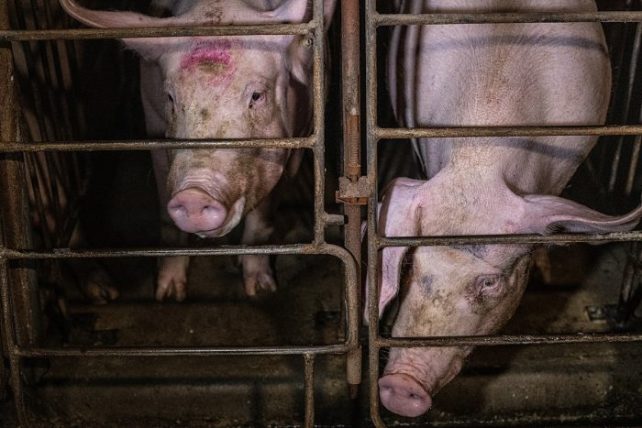
Gestation crates at an industrial pig farm in Quebec.
Jo-Anne McArthur/We Animals Media
That outrage has mobilized a second, more aggressive wave of activism in recent years, as embodied by the 2019 occupation of Excelsior. Soranno has been a protagonist in many of them.
In August 2019, Soranno led a sit-in at a chicken slaughterhouse run by Maple Leaf Foods in Toronto. Once inside, she chained herself to a cement block on the kill floor with three other activists. In October 2021, Soranno was invited to speak at the Canadian Animal Law Conference in Waterloo, Ont.; the morning after her talk, she’d planned to join the occupation of a nearby turkey farm, but police arrested her en route—authorities had been tracking her movements since she landed at the airport. That action went ahead without her, led by Jenny McQueen, who, in circumstances nearly identical to Soranno’s, is now awaiting her own sentencing for the occupation of Porgreg pig farm in Quebec. McQueen’s hearing is scheduled for December, two months after Soranno’s. Authorities have barred the two women from communicating.
“It’s all about spreading awareness,” McQueen said when I reached her by phone in August. “My hope is, each time a court date comes up, we’ll get media for it.” But McQueen, who has been arrested seven times for these actions, acknowledged this kind of activism “is something I’m going to struggle with in the future. Because the charges are getting more and more serious.”
The heightened legal response to Soranno, McQueen, and others is only one aspect of the state’s response to their activism. A more systemic one is the spread of so-called “ag-gag” laws, which criminalize undercover operations altogether. Alberta and Ontario have already passed ag-gag laws, making it a crime in those provinces to seek farm employment for the purpose of capturing undercover footage. Manitoba and P.E.I. have also passed watered-down versions of the same.
“What we’re seeing now is the backlash from the farm community, based on increased activism,” Labchuk with Animal Justice said. That backlash reflects the immense lobbying clout of the farm industry, which brings billions of dollars into provincial and federal coffers each year and employs hundreds of thousands of Canadians. “I can’t say I’m surprised by it because we went down this road in the U.S. But I’m not sure it’s good for them in the end.”
A wave of ag-gag laws swept through numerous US states in the 2010s, also in reaction to numerous farm exposés there; most were quickly struck down by court rulings that found they violated the First Amendment. Animal Justice is now fighting the Ontario law in court on similar grounds, namely arguing that it violates Canadians’ right to freedom of expression.
“They’re shooting themselves in the foot,” Labchuk said. “Of all the issues we’ve worked on, there’s few that have the emotional resonance that ag-gag laws do. People want to know what the farmer’s trying to hide. And if you Google that question, you pretty quickly see those images.”
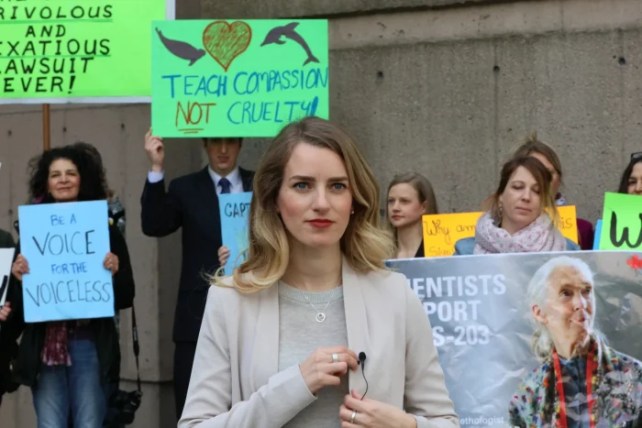
“What we’re seeing now is the backlash from the farm community, based on increased activism,” says Camille Labchuk.
Courtesy of Camille Labchuk
The only protection afforded Canadian farm animals are codes of conduct set forth by the National Farm Animal Care Council (NFACC). The NFACC is comprised almost entirely of industry groups like the Dairy Farmers of Canada and the Livestock Truckers Association, though it also includes a handful of provincial and federal government representatives and two animal-welfare organizations. These guidelines are entirely voluntary. Labchuk described them as “the industry’s attempt to avoid regulation.”
In 2017, the NFACC set a new goal to phase out battery cages for egg-laying hens by 2037. It also said it would end the use of gestation crates for pigs by 2024, but two years ago pushed that target date back to 2029. “Even when these codes do include something positive,” Labchuk said, “we end up in a situation where they’re not laws, they’re not enforced and industry does what it wants anyway.”
The NFACC’s general manager, Jackie Wepruk, responded to an interview request with an email saying: “NFACC isn’t a regulatory body. We are a collaborative partnership of diverse stakeholders created to share information and work together on farm animal care and welfare.” Wepruk directed me to “provincial enforcement authorities for animal protection.”
Claims of farm animal abuse are investigated by different authorities in each province. In some provinces, like Quebec, it’s the Ministry of Agriculture that looks into them. But in most others, like BC, it’s the SPCA. Marcie Moriarty is the BC SPCA’s chief prevention and enforcement officer who oversees the animal protection unit.
“The government in BC has said, ‘Citizens of BC, you should feel good about farm animal welfare because we have the Prevention of Cruelty to Animals Act,’” Moriarty told me. “That is a copout. We should be holding industry and government accountable to ensure that minimum standards of farm-animal welfare are in place.”
I asked Moriarty if the apparent rise in “happy” meat didn’t reflect some measure of industry response to the ethical problems of factory farming. A trip to my local organic store in Vancouver reveals an array of packaging assurances that turkey is “free range” and “certified humane;” chicken that is “family farm raised” and also “free range;” pork that is “naturally raised” with “no growth hormones or antibiotics added;” and various other promises that the animal products I’m consuming imposed no suffering on the victims.
“That is a smoke-and-mirror show worth billions,” Moriarty said, making clear that this is a national issue. “For the average Canadian, what they’re being told is you should be reassured by the fact that you live in Canada and we care about animals. The problem is, you can’t know what’s behind the barn doors.”
When you talk to animal rights advocates and activists, sooner or later they all mention Nathaniel Erskine-Smith. He is the Liberal MP for Beaches-East York, founder of the Liberal Animal Welfare Caucus, a lifelong vegan and by all accounts, the single most active policymaker on this file in Canada.
“We’re talking about externalities here,” Erskine-Smith told me. “With large-scale industrial agriculture and factory farms, you have a low-cost good on the backs of harm to animals—ruthless efficiency at the expense of basic dignity for animals that obviously should be treated with compassion.”
He agrees pushback from industry is the biggest obstacle to change. “In Ontario, it’s $7.5 billion of cash receipts for livestock last year,” he said. “I don’t think this gets solved in the short term whatsoever. It’s incredibly hard when you have the interests of animal welfare run up against basic economic interests that tend to loom much larger in our political dialogue.”
Erskine-Smith sees many parallels between the animal rights movement and the climate movement—and not just because meat and dairy production account for some 15 per cent of global greenhouse gases. Activists in both communities have tended to condemn industry without giving much thought to workers, he said, noting how long it took for environmentalists to embrace the concept of a “just transition”—a phrase which also happens to be gaining currency in animal rights circles. “We have to appreciate that there are long-standing cultural and economic connections to animal agriculture at the same time as we look to reform egregious practices.”
Erskine-Smith cited the UK as one model for change: 22 years ago, the British banned fur farming but made sure to compensate farmers along the way. “Unless you take that kind of approach,” he said, “it’s going to be a massive struggle because [farmers] are going to say, ‘My livelihood is on the line and I see no alternative, so I’m going to fight this with everything I’ve got.’”
That’s the reality Soranno, McQueen, Nick Schafer and many more activists now confront. They’re all keenly aware of the irony that instead of improving the lives of farm animals, their activism has made it harder for people to expose the suffering of those animals.
But state backlash against them may yet prove to be a temporary setback in the arc of a much longer story.
“We are now at a place in 2022 where this isn’t about animal activists versus industry,” Erskine-Smith told me. “This is about a really broad and deep support across Canadian society for strengthening animal protections. So people need to be vocal, they need to be organized, they need to be expressing that broad and deep support. And that support has to be respected by legislators.”
Labchuk also sees cause for optimism. “I don’t think it’s going to be too much longer before we see provinces under so much pressure to ban some of these practices that they’re going to have to,” she said. “The story of social change is hills and valleys. We don’t know what issue is going to take hold or what market factors might prompt a big realignment at some point. But I think one of those things that we can kind of forecast is climate change.”
Soranno’s sentencing date will come long before those predictions can be measured. Crown prosecutors have asked for jail time. That would mark an unprecedented punishment for a sit-in-style act of civil disobedience. It’s impossible to predict what the judge will decide, but Soranno’s long history of trespass and her refusal to express remorse at any point in the trial won’t work in her favor.
She remains unfazed. “Even in a jail cell,” she told me, “I am given more freedom than animals inside commercial farms.”


